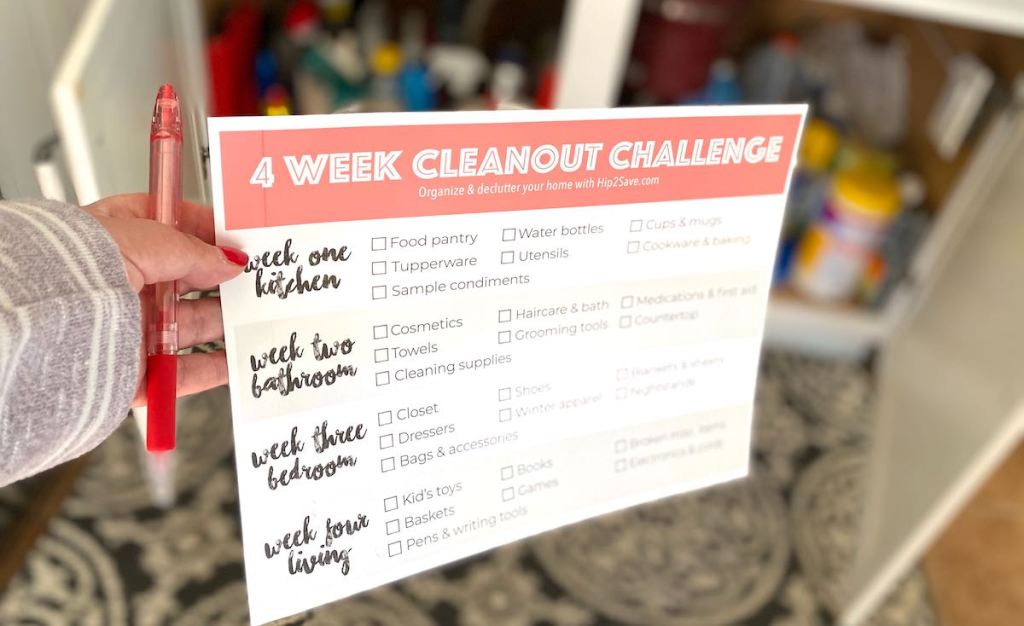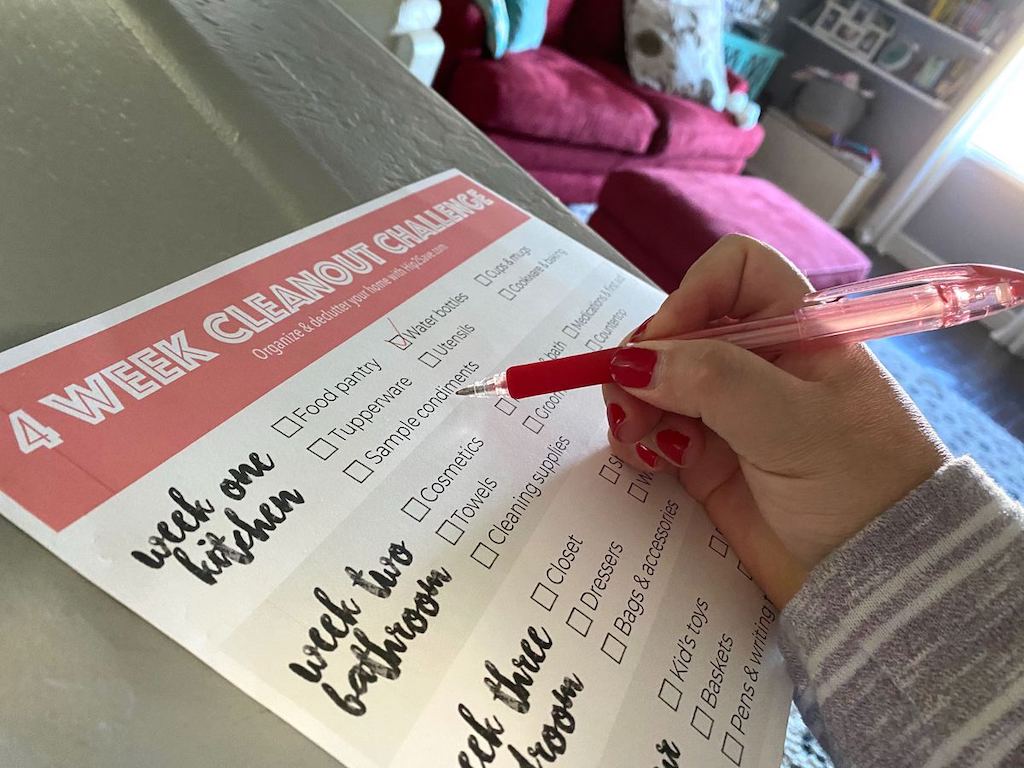You only need 4 weeks to achieve a more organized, decluttered home! 🤩
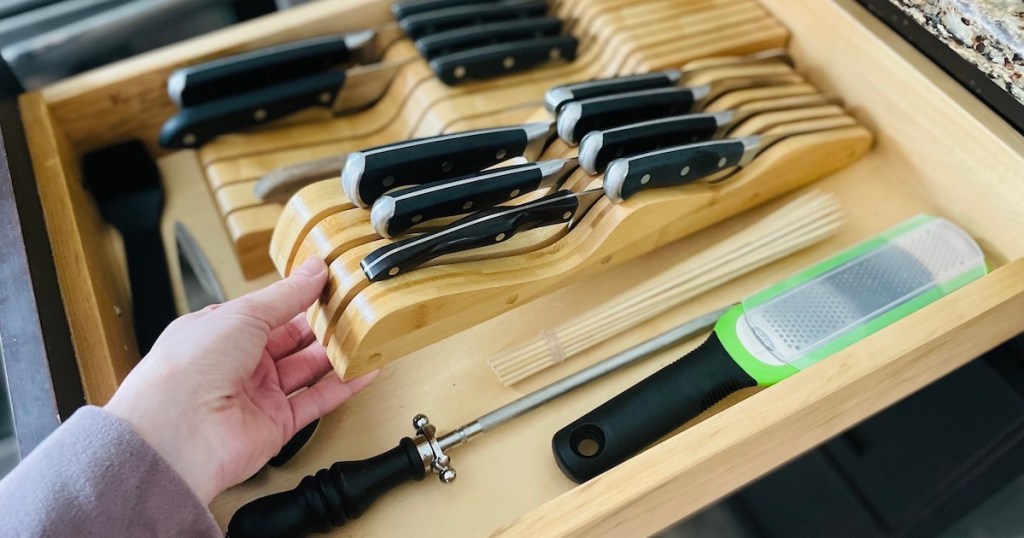
Let us help you get organized!
Our helpful 4-week cleanout challenge. We show you how to declutter your home in just 4 weeks going room by room with our free printable.
Even though there are so many ways to keep your house spotless every day, sometimes you just need to do a good cleanout to get things in tip-top order. To help, we’ve created this challenge that gives room-by-room tips on how to declutter your home in just 4 short weeks!
We even have an easy-to-follow printable to keep you on track and if you read until the end we’ve even included a bonus checklist. Marie Kondo style! 😍
Week 1: Kitchen
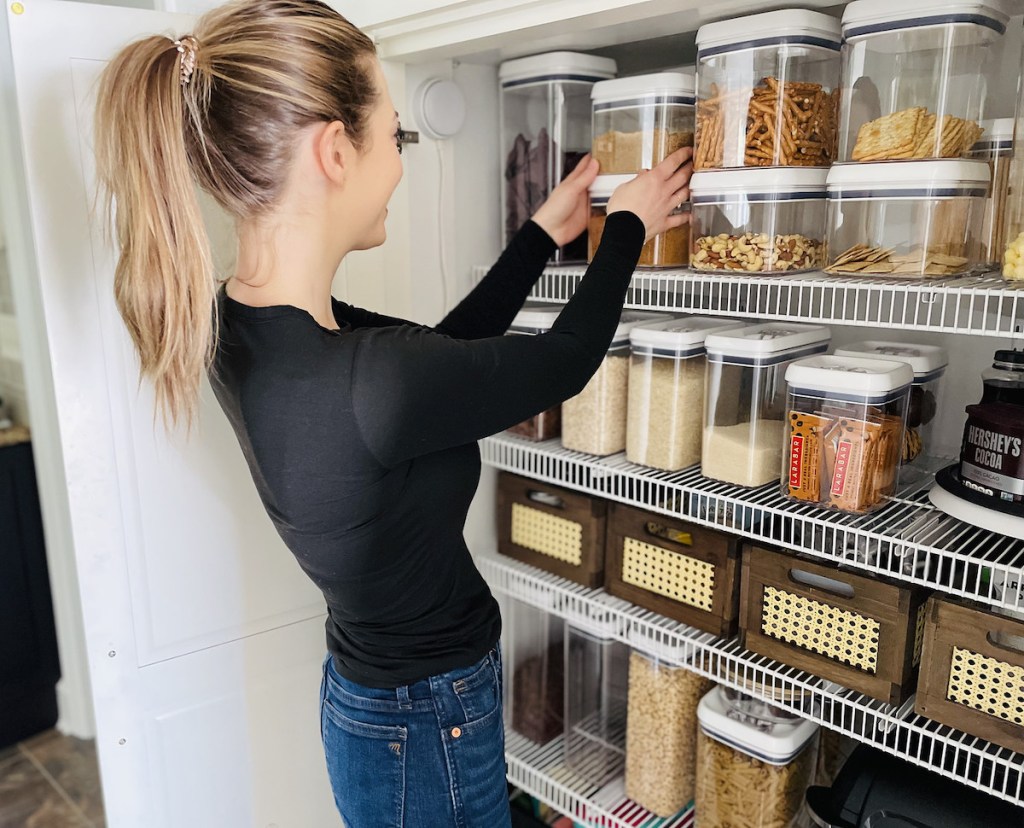
1. Food pantry
Empty everything out of your pantry. Throw out expired food and make a separate pile for duplicates that can be donated. Group remaining items accordingly (spices, pasta, dry baking necessities, etc.). Place your most frequently consumed foods at eye level and kids’ snacks a little lower so they can easily grab one if needed. For more pantry tips, check my Hip sidekick, Lina’s, pantry organization post.
Rule of thumb: Make sure to do this before your next big grocery shopping trip so you know you won’t be stocking up on food that could go to waste again.
Hip Tips: I highly recommend investing in some organizational items. Check out how I organized my pantry using affordable containers from Walmart!
2. Plastic storage containers
Plastic storage containers are a huge culprit for messy cabinets. It’s time to clean out the cabinet, make sure you have matches for each piece, and only place those sets back in the cupboard so they’re easily accessible. See about donating those missing pieces and recycling ones that are broken.
As an idea, you can also check the warranty on your plastic storage containers, like Tupperware. You may be entitled to a replacement set if your current ones have broken!
Rule of thumb: Keep about 3 pieces per family member and 4 pieces extra if you constantly have leftovers or use them for lunches. Keep a week’s worth of the same size containers so they’re easy to stack if you meal prep frequently.
Hip Tip: Get more bang for your buck by checking deals on top brands like Tupperware, Rubbermaid, Lock n’ Lock, and more! Also, be sure to check out our favorite meal prep containers on our sister site, Hip2Keto.
3. Water bottles
Empty out your cabinet of water bottles and match them up and throw out any bottles that are broken or leak. You can also donate the ones that don’t have a lid or that you just might not love anymore. Put the remaining bottles back into your cabinet.
Rule of thumb: You really only need one great water bottle per family member. In case one gets lost or broken, keep up to 2 extras on hand. This will limit your cabinet chaos.
4. Utensils
Empty out your entire utensil drawer onto your counter. Donate things that you never use and throw out anything that’s broken. Group remaining items (spoons, ladles, tongs, etc.) together. Consider buying an adjustable utensil organizer so items stay in place and put them back into the drawer by their designated groups.
Rule of thumb: To minimize clutter, 2-3 place settings per person will suffice, and only keep a maximum of 2 duplicates of larger utensils. For extra utensils that you only use on special occasions, consider storing them elsewhere.
5. Sample condiments
Chances are you won’t ever eat the 50 packets of soy sauce at the bottom of your drawer. Especially considering you’ll likely get another 10 packs of the same sauce for your next takeout order. Empty out your collection and ask a neighbor if they’d like them and maybe consider saving just a few for the kid’s lunches.
Rule of thumb: Unless you find yourself using these on occasion, most people don’t need them laying around. Throw them all away or at most, keep up to 5 of your favorites.
6. Cups & mugs
Empty your drinkware cabinet of plastic cups, coffee mugs, and other drinking glasses. Group them all by matches and donate any mix-matched ones that don’t mesh well or that you just don’t love. Place back into your cabinet by groups, stacking any plastic cups that you can, or display them on a mug rack.
Rule of thumb: Keep up to 2-3 everyday drinking glasses per person, 1-2 mugs, 2 wine glasses per adult (extra if you entertain on occasion), and a stack of plastic reusable cups.
7. Cookware & baking
Empty out all of your pots & pans, baking sheets, cutting boards, etc. Match each pot and pan with its designated lid, turning upside down to make stacking them easier. Donate any pots and pans that you never use or have a hard time cleaning up. Place back into the cabinet stacking pots and pans from largest to smallest or use an organizer. Nest casserole dishes and stack cutting boards, baking sheets, and muffin tins on their sides or place them in an upright organizer.
Rule of thumb: You only need one matching set of pots and pans, 1-2 muffin tins, a small and large baking pan, one set of nesting casserole dishes, one really great cutting board for veggies, and one for meat.
Hip Tip: We shared our team’s favorite chemical-free cookware and bakeware if you’re in the market for a new set!
Week 2: Bathroom
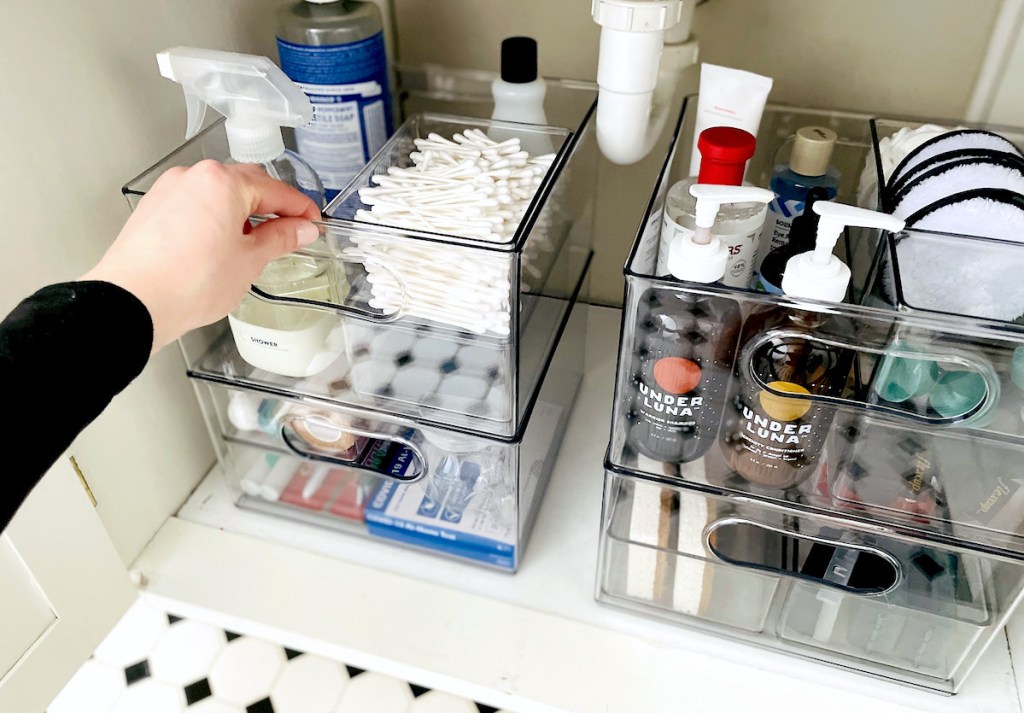
1. Cleaning supplies
Take out all of your cleaning supplies and group them by their purpose (bathrooms, hardwood floors, etc.). Properly dispose of or donate any cleaners that you haven’t used recently or no longer serve a purpose. Then consolidate duplicate cleaners where you can. Place cleaners back into the cabinet with already open cleaners towards the front.
Rule of thumb: Only keep one cleaner for each purpose in your home. For example, only keep Windex for cleaning glass and mirrors, Lysol for bathrooms, etc.
2. Cosmetics
Dump out your bag or drawer of cosmetics. Group all items together such as mascara, brushes, eyeshadows, foundations, etc. Throw out any cosmetics that are empty, expired, or haven’t been used in the last 6 months. Place it back neatly into your bag or drawer and even consider buying some acrylic organizers to keep everything in its place. Stand all makeup brushes in a cup that you have laying around.
Rule of thumb: If you’re not a huge makeup enthusiast or a professional makeup artist, you can keep just one of each item for your daily makeup and night-out makeup routines. (i.e. 1 mascara, 1 eyeshadow pallet, etc.)
3. Towels
Take out all the bath and beach towels. Decide which ones you’d like to keep and which you want to donate. If most of your towels are dingy and ripped, it’s also okay if you’d rather just donate them all to the local shelter. It frees you up to get a whole new set and start from scratch (we love these Costco towels). Either way, fold your towels evenly and neatly into stacks of 3-4 each. Place beach towels higher in your closet and bath towels at eye level.
Rule of thumb: Make sure to have 1-2 bath towels and 1 beach towel per person in your house, plus 2 extra bath towels and 2 extra beach towels on hand for when friends & family visit. When folding laundry, fold towels the same way every time so stacking stays nice and neat.
4. Haircare & bath products
This includes anything you use to do your hair including, gels, hairsprays, and so on plus any additional bottles including lotions, sunscreen, shampoos, and more. Empty out all contents from drawers and cabinets. Try donating any that you no longer use and don’t love. Place items either on a pull-out shelf for easy access or into a basket so they’re not just floating around your cabinets.
Rule of thumb: If you have random products laying around and you haven’t used them in the last year, it’s time to ditch them. Only keep one item per purpose. One hairspray, one good body lotion, etc.
5. Grooming tools
Take out all of your brushes, combs, hair ties, and styling tools, and ditch any that are way overdue for a replacement. Now would also be a great time to clean your hairbrushes if you’ve been neglecting that task.
If you don’t already have a special place for these items, I recommend hanging all of these items using easy-to-hang Command hooks. You can even put all your hair ties on a metal ring to hang so you’ll never be looking for them again.
Rule of thumb: Only keep one grooming tool of its kind. For hair ties, throw them away once they start to lose their elasticity or start to break.
Hip Tip: You can use a $1.25 Dollar Tree paper towel holder to easily store scrunchies and it can double as decor.
6. Medications & first aid
Lay out all of your prescription and over-the-counter medications along with all first aid essentials. Check expiration dates for all medications and creams, then properly dispose of them. Group things according to purpose and place them on a lazy susan, in a basket, or even get an organizer for your cabinet.
Rule of thumb: It is never recommended to consolidate medications into the same bottles. If you’re trying to get rid of some bottles, dispose of all contents responsibly or make sure to use up the bottle with the least amount in it first.
7. Countertop
This is an obvious area that might need some attention, but nonetheless, the countertop can be the quickest area to become cluttered. Start by clearing off the entire surface and clean your countertop and sink. Refill your soap dispenser and put it back in its place and clean your toothbrush holder and place it back by the sink. Lastly, place back any decorative items, such as a sign, towel, or small plant.
Rule of thumb: The only items that you need on your countertops are your toothbrush holder, soap, a hand towel, and one piece of decor. Anything else needs to find a new, permanent home.
Hip Tip: You can also use this outlet shelf to organize your electric toothbrushes or even get your music devices off the counter.
Week 3: Bedroom

1. Closet
This is likely going to be the most time-consuming task so I’d recommend doing it on a day you have a couple of hours to spare (Note: the time it takes will vary greatly on how many clothes you have). I want you to empty your ENTIRE closet. Yes, everything.
Then create three piles as you go, one for donating, a keep pile, and one for trash – these would be items that are stained or have holes beyond reasonable repair, but of course, I recommend first calling your local shelter to find out what they will and will not accept for donations before putting them in a textile recycling bin. And remember, even clothes with holes could be used as rags, sewn into napkins, or even given to animal shelters.
Once you’re done, clear out your donate and trash pile so you already feel a weight lifting from your space (and that nothing sneaks back into the closet). Then assess what you want to hang, fold, or put in storage if you’re a seasonal closet person. Hang items back into your closet by color and season (jeans stick together, long sleeves, etc.) and fold sweaters to put on shelves or in a drawer.
Rule of thumb: Only keep what you’ve worn in the last year and items you absolutely love. Your clothes should make you feel great, not decent at best.
Hip Tip: Here’s how you can upgrade your wardrobe without spending a cent!
2. Dressers
Empty out all of your drawers and dressers. Similar to your closet, you’ll need to make a keep, donate, and trash pile. Ideally, you’d like to be able to put back each item per drawer, so make sure you’re grouping items together as you take them out: T-shirts in one pile, underwear & bras, pajamas, etc.
Fold all t-shirts, pajamas, sweatshirts, etc. using the Marie Kondo folding method so that all pieces are able to stand on their own. This will keep your drawers neat and much more functional. Then place them back in their coordinating drawer.
Rule of thumb: For a very minimalist approach, keep 1-2 weeks’ worth of underwear, 2-3 bras (one strapless), 3 sets of pajamas, and no more than 5 t-shirts and 2 sweatshirts. Most importantly, only keep items you absolutely love.
Hip Tip: Use some drawer organizers to keep smaller essentials like socks, underwear, and even smaller kids’ clothes in order.
3. Bags & accessories
Belts, suit ties, handbags, hats, and any other accessories need to be gathered together. Decide what you’d like to keep or donate. Then think about where you’d like to place each item. Wide-brim hats hang great on walls and can double as decor or they’ll take up less space in your closet. Use a tie & scarf hanger along with a belt hanger to hang these smaller items back into your closet neatly. Handbags should be placed on top shelves or hooks.
Rule of thumb: Just like your clothing, only keep the accessories that you’ve worn or used in the last year, and most importantly only keep items that you absolutely love. Accessories are meant to enhance your outfit, not bring you down.
4. Shoes
Whether you keep them in your mudroom, garage, or foyer, it’s time to empty all the shoes. Make a donation pile for any shoes that your kids have outgrown and that you no longer enjoy wearing. This is also the time to clean up any pair that look a little rough around the edges.
Consider parting with a pair you’ve only worn once or twice as it could be cash in your pocket. Then place them back onto your shelving unit or closet by season.
Rule of thumb: Make sure you keep at least one staple pair of shoes for each season or type of weather. It’s great to have one solid pair of rain boots, heels, sandals, etc., that can go with anything.
5. Winter apparel
Take out all of the jackets, hats, scarves, mittens, etc., and make a donation pile for anything that your kids have outgrown or that no longer gets worn. Match up pairs of gloves and mittens then assess what goes back in the closet. Place smaller items into baskets by groups: hats in one, matching gloves and mittens in another, then scarves, and so on.
For coats, I find wooden hangers to keep them the most organized, plus they’re sturdy enough to keep everything hanging in nice, neat order.
Rule of thumb: For each person, keep a maximum of 1 good winter coat, 1 raincoat, and 1 dress coat. Anything more than that is considered extra and not needed if you don’t have the proper space.
6. Blankets & sheets
These items are likely hanging out in a linen closet somewhere, so empty out all the sets of sheets, pillowcases, and extra blankets. For the sheets, match up each set with its coordinating fitted sheet, flat sheet, and pillowcases and place them back into the closet. Blankets that you love need to be folded neatly and either placed in a basket or on upper shelves if not used frequently.
Anything without a match or that’s no longer loved can be donated to your local shelter or SPCA.
Rule of thumb: Each bed in your house should have 1 extra pair of sheets, totaling no more than 5 extra sheet sets. For guest visits, you should have two extra blankets.
7. Nightstands
You’ll sleep more soundly with a clean and organized nightstand. Empty everything out, recycle old papers, and get rid of the trash that has accumulated over time. Find a home for smaller items such as coins, hair ties, etc. as they don’t need to go back in your drawer. Place back essential items that you use regularly such as lotion, books, or chargers.
Rule of thumb: The top of your nightstand should always remain clean. At maximum, you should have no more than a lamp, a dish for everyday jewelry (earrings, watches, etc.), a candle or piece of decor, and a book to read at night.
Hip Tip: We love The Home Edit line at Walmart for all things organization!
Week 4: Living

1. Kid’s toys
Take out everything in your kid’s toy box (this is a great time for them to help get organized too!). Group similar toys together, such as Legos, building blocks, Barbies, balls, etc. Get rid of any small items that are broken beyond enjoyment and donate what has been retired at the bottom of the toy box for months.
Your donation pile contains items that don’t get played with anymore and is also a great way for your kids to participate in this cleanout so they can let you know what they no longer enjoy playing with. Place grouped items that you’re keeping back in bins or boxes by category.
Rule of thumb: Any toys that are missing pieces and/or haven’t been played with within the last 3-6 months are toys that should either be donated or recycled. Make sure there’s a balance between educational and fun toys.
2. Baskets
Baskets are one thing that I can’t resist buying sometimes, but it’s important to gather up what you have and make sure that every basket you’re using has a purpose, and donate the ones that are just taking up space.
Rule of thumb: Only keep baskets that you actually love. Anything less than that shouldn’t have a place in your home.
Hip Tip: These Room Essentials baskets at Target often go on sale for 50% OFF and are as cheap as $2 each!
3. Pens & other writing tools
Chances are about half of the pens hanging around your house don’t even work, so empty out that junk drawer and test out all the pens, markers, highlighters, etc. so you know which ones to keep. The next time you really need a pen, you’ll be glad you did this.
Rule of thumb: Keep no more than 5 good pens, 1-2 pencils per person living in your house, and 2 highlighters.
4. Broken misc. items
The options for this category are endless and can vary greatly per household. Did you drop a knick-knack a few months ago that you’re probably never going to fix at this point? If it doesn’t have a significant sentimental value, it’s time to either trash it all or take the time to fix these items around your house so they can go back to serving a purpose in your home.
Rule of thumb: If something appears to be unfixable, it’s okay to trash it even if it has sentimental value. Something that you’re likely holding onto is better served as a memory (which can never break and no one can take it away from you). It’s a win, win.
5. Games
If your hallway closet is anything like mine, it may be overflowing with board games and puzzles. Game nights are great and I’m totally here to encourage you to keep it up! However, it’s time to organize the chaos. Start by emptying out all of your games and puzzles and make a donation pile, a keep pile, and a trash pile (for games that are totally dilapidated).
For games that you’re keeping, go through and make sure they’re organized (you’ll appreciate this on your next family night). Then place them back into the closet, with larger boxes on the bottom. Place less-played with toys toward the top shelves and more frequented games where they’re easily accessible.
Rule of thumb: I’m never going to limit a family on their game nights, so keep all the games you want, but just make sure you have the proper space for them all. Any kid-appropriate games you’re parting with will be greatly appreciated at your local grade schools!
Hip Tip: Shop our team’s favorite family, teen, kid, and adult games if you’re looking to add a few to your collection after getting organized!
6. Electronics & cords
Have a box filled with random cords, cables, and electronics laying around? Dump them out, match them to the device that they’re used for, and properly dispose of or donate any extras or miscellaneous cords and electronics. Neatly fold all cords or put them in an organizer. Don’t stress over the fact you may need them one day, chances are if they haven’t moved from the box since you last moved, you’ll never need them.
Rule of thumb: Each household should only have one charging cord per phone or device. Duplicates can be donated or trashed accordingly.
7. Books
It’s time to go through that overflowing collection of books. While books are great, there might be some that you no longer want or some that are no longer relevant. Take them all off the shelves and give each shelf a good dusting before you do anything else. Decide which books you’ll be keeping and which ones you’ll be donating. If you have a lot of books, group them by genre and place them back on the shelves accordingly.
Rule of thumb: Books are knowledge, so just like your family game nights, the sky’s the limit, friends. Just make sure that you’re happy with your collection and are only keeping books that really bring you joy.
WAIT!!! Want to take your decluttering even further?
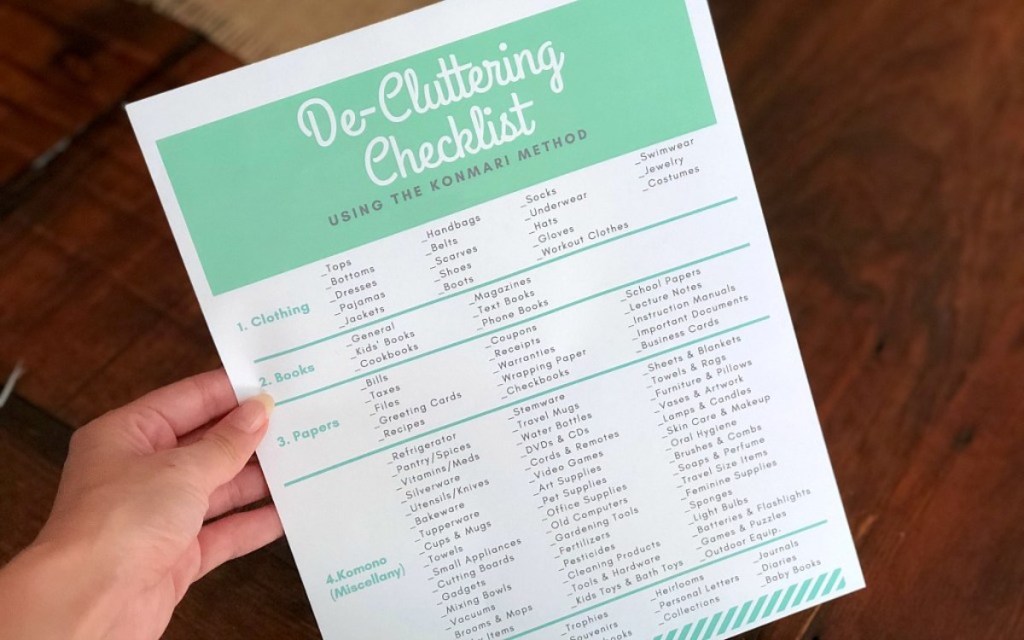
You know that bonus checklist we were talking about? Well, here it is! If you need to go full-on Marie Kondo to all the rooms in your home, meaning you’re truly trashing anything that doesn’t “spark your joy”, then this in-depth checklist will help you tackle all your clothing, books, papers, mementos, and miscellaneous items in a focused, checklist format.
With this complete list to tackle literally everything in your home, you’ll be sure to have the most decluttered and organized home on the block. 😉
!doctype>

